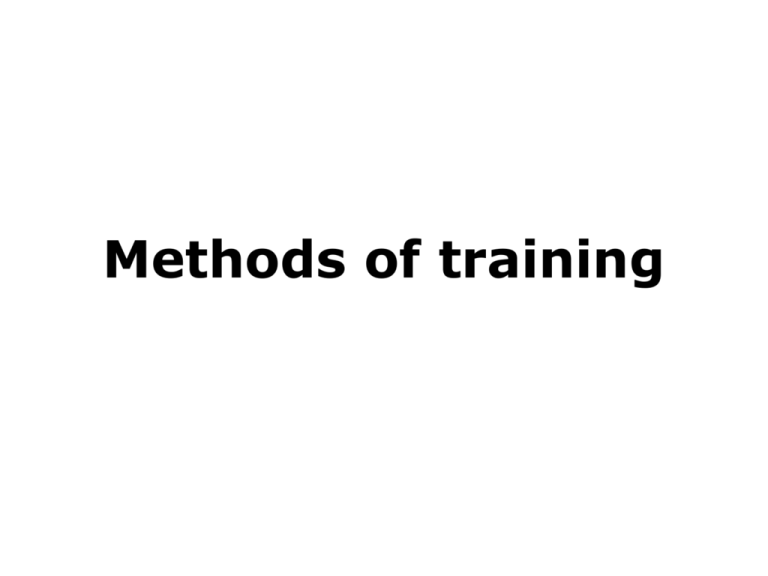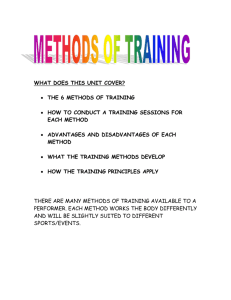Methods of training
advertisement

Methods of training 1 Methods of training Methods of training 2 What you will learn about in this topic: 1. Methods of training 2. What training develops 3. How each method works Methods of training 3 Learning objectives By the end of this presentation you should be able to: • Understand the different types of training methods • Describe what each training method develops • Explain how to carry out each of the different methods Methods of training 4 Methods of training Each of the following methods of training work the body differently: • Interval training • Weight training • Cross training • Fartlek training • Circuit training • Continuous training Methods of training 5 Interval training Interval training involves periods of exercise followed by periods of rest. There are two types of interval: 1. Short 2. Long Methods of training 6 This method can be adapted to develop different types of fitness. Short bursts of pace, using anaerobic respiration, needed in games play, uses short interval training. Methods of training 7 Prolonged moderate to hard pace, using aerobic respiration, needed in middle-distance running events, uses long interval training. Methods of training 8 Interval training is suited to individuals working on their own, small groups of people and larger numbers such as teams. It is intensive and should be performed with accuracy and at competition pace. Methods of training 9 The times of rest allow performers to regain energy so they do not become too tired to carry on training. The times of exercise are repeated to form repetitions. Four or five repetitions make up a set. There may be four or five sets in a session. Methods of training 10 Task 1. Make a list of three potential benefits and three disadvantages of interval training. 2. Add an explanation to each of the benefits and disadvantages you have listed and link them to specific sports examples. Methods of training 11 Continuous training The continuous training method exercises the body at a moderate rate, keeping the pulse at a constant level above the training threshold. Methods of training 12 This training works the body aerobically and keeps the pulse at a moderate to high rate. Its effect is to improve the cardiovascular and respiratory systems. After a gradual warm-up, the person training works their body at a moderate level throughout the session. Methods of training 13 The heart rate is above 60 per cent of its maximum but below 80 per cent. By keeping in this zone the work is aerobic and can carry on for a long time. Continuous training suits those new to training or those recovering from injury. Methods of training 14 At the start of a season, continuous training can help to re-establish the cardiorespiratory levels. At this level, the work is moderate but can be adapted to be harder at a later time. Methods of training 15 Circuit training Circuit training is a series of exercises, completed for a certain amount of time, one after the another, developing aerobic and anaerobic respiration. Methods of training 16 When using large muscle groups at each station, aerobic respiration is in operation and this will develop the cardiovascular system. If exercising small muscle groups in turn (such as the biceps and triceps), this is anaerobic, which builds strength. Methods of training 17 A circuit is made up of several activities. Each activity is given its own space (a station) in the gym or sports hall. Each activity is completed as many times as possible. These are called repetitions. Methods of training 18 Task How many of the following circuit training activities can you name? Methods of training 19 Methods of training 20 There is a set time for each activity, usually between 30 and 60 seconds. In this time as many repetitions of the activity are performed as possible. When all exercises at each station have been completed, the circuit is finished. Methods of training 21 By repeating the circuit or adding exercises, the session increases in intensity. For general fitness the sequence of exercises works different muscle groups at each station. Methods of training 22 Weight training Weight training involves shifting weight to increase the strength of muscles, using a programme of repetitions and sets. There are two types of weight training: 1. Machine weights 2. Free weights Methods of training 23 Before deciding on the amount of weights and which weight training method is suitable for them, the performer will need to know what they want to achieve. They will need to know if they want to achieve aerobic (endurance) or anaerobic (strength) development. Methods of training 24 Machine weights are technically designed to move in the correct way and are adjustable for different sizes of user. Methods of training 25 They are safe as they are steady and do not vary position apart from the designed range. This also has the effect of not training the stabilizing muscles that may be needed for a sport. Methods of training 26 They usually have supports and belts to make sure the body is prepared in the correct position to shift the weight. However, a drawback is that extra weights cannot be added to the machines. This limits their use for the advanced performer. Methods of training 27 Free weights can be used in a weight-training programme. Methods of training 28 The use of free weights is specialized and needs lots of training so that the performer works safely. Many top sportspeople use free weights. Methods of training 29 A person training with heavy weights must always use a spotter; this is a person who helps steady the performer and is ready to catch the bar or assist if the performer is struggling. Methods of training 30 Free weights: More weight can be easily added Injury can occur due to poor stance and posture Provide a wider range of exercise than machines Develop explosive strength A spotter is required if heavy weights are used Skill is needed to life heavy weights correctly Methods of training 31 Fartlek training Fartlek training involves exercise, often running, varying in time, distance and effort. Fartlek is a Swedish word meaning ‘speed play’. Methods of training 32 Due to the changes of intensity of the exercises, Fartlek training works on both aerobic and anaerobic fitness. The athlete then becomes increasingly capable of meeting the changes of pace in a competition or game. Methods of training 33 Sprints, jogs and runs make up the session. These may have times set for them or may be for a certain distance. Methods of training 34 An example of a Fartlek training session: Run Jog Rest Sprint Walk Methods of training 35 The session can be continuous with periods of intense work followed by rest periods or less strenuous exercise easier work, which gives the body a chance to recover. Methods of training 36 Cross training Cross training combines different methods of training and is adaptable to a variety of situations. Each activity improves different muscle groups giving a wide range of development for the body. Methods of training 37 By changing the activity, parts of the body are able to rest, preventing over-use injury. The variety of sessions can also make training more interesting. Cross training can be adapted to suit individuals: a person may choose to run, play a game or do some aerobics work, for instance. Methods of training 38 As cross training can be used for developing general fitness, this method allows individuals to work on their own or in a group. Methods of training 39 For those working in a group, as the activities change the groupings can change. This can widen the number of people a person knows as they train with a different group for each activity. Weather does not stop training as the sessions can be changed: an indoor session can be completed instead of an outdoor one. Methods of training 40 Exam questions 1. What type of training would be most useful for a team sports athlete to increase their stamina? Explain your answer. Methods of training 41 2. Which of the following are types of training? A. Fartlek, continuous, contemptuous, cross, aptitude B. Continuous, Fartlek, weight, cross, aptitude C. Potential, circuit, weight, cross, Fartlek, interval D. Circuit, continuous, weight, cross, interval Methods of training 42 What you have learnt in this topic: 1. Methods of training 2. What training develops 3. How each method works Methods of training 43 Learning objectives You should now be able to: • Understand the different types of training methods • Describe what each training method develops • Explain how to carry out each of the different methods







